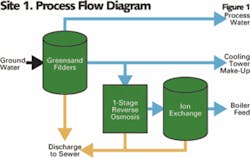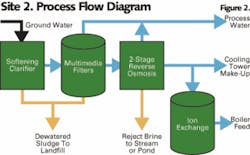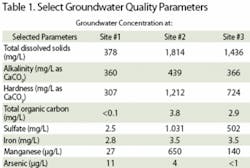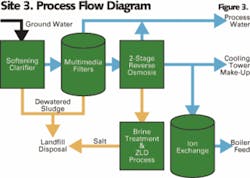One Size Does Not Fit All: Comparing Water Solutions for Three Ethanol Plants
by Pierre Kwan
Ethanol plants require several types of water: process water for product production, boiler feed water and cooling tower makeup water. In total, about 4-to-6 gallons of water is required to manufacture 1 gallon of ethanol. For a 120 million gallon/year (MGY) ethanol facility, this equates to a constant supply of 900-to-1,400 gpm of water while the facility is operating. Producing this water requires several different treatment steps, which in turn results in the need to dispose of several types of residuals.
As an example, Site #1 in the Midwest has access to high-quality groundwater to support about 120 MGY of ethanol production. This source is low in total dissolved solids (TDS) and well within the range of acceptable limits for most parameters (see Table 1). The water contains iron and trace amounts of arsenic, however, which necessitates installation of greensand filters. Filters also remove any sand and silt that could come from the well. Single-stage reverse osmosis (RO) further purifies the water prior to use as process and cooling tower makeup. Ion exchange filters treat the RO-treated water as a final demineralizing/polishing step prior to boiler use. The greensand filtration results in an arsenic-laden backwash sludge while the RO and IX units produce highly saline reject brine. Site #1 has the luxury of nearby sanitary sewers. An analysis indicated the industrial discharge wouldn’t significantly affect the municipal wastewater collection or treatment system. As a result, all backwash water and sludge, as well as reject brines, discharge to sewers for a nominal connection charge and monthly service fee.
Site #2, also in the Midwest, has nearly identical water quality and quantity requirements. It’s located, however, at a site with poor quality groundwater for source water. The site has no nearby sewer service but is relatively close to a stream. The poor groundwater means this second facility needs substantial lime and soda ash softening and clarification equipment to reduce water hardness, followed by multimedia pressure filters to remove any solids carryovers from the clarifiers. The softened water is still highly mineralized, so more substantial two-stage RO units and larger IX filters are required to treat water to the required level.
Softening sludge is dewatered onsite using a plate-and-frame filter press prior to landfill disposal. RO brine discharges to the stream, but this discharge is complicated by the fact the water body is frozen, with little to no flowing water, for four months of the year. As a result, discharge is subject to flow-based restrictions that vary by month. Complying with the discharge permit required construction of about 16 acres of onsite ponds to store brine during months when discharge isn’t allowed. To reduce the discharge flow rate and necessary brine storage, the owner of Site #2 contracted with the IX vendor for off-site regeneration. The vendor removes the exhausted IX filters and installs fresh filters as necessary. In addition to savings for smaller brine storage ponds, onsite regenerant brine makeup and storage facilities are no longer required and the overall building size is smaller and less expensive.
As a final comparison, a third facility nearly identical to the other two is sited near Site #2 and also has poor groundwater quality. The treatment process is similar to the Site #2 facility, in which lime and soda ash softening and multimedia filtration are used as pretreatment to two-stage RO purification units and IX polishing filters. There are no available streams or sanitary sewer systems, however, to discharge generated liquid water treatment residuals. To enable the plant to obtain operating licenses, the facility had to go to a complex, expensive zero-liquid discharge (ZLD) process.
The first step in the ZLD process was to minimize brine volumes. As with the Site #2 facility, IX regeneration at Site #3 also is being conducted offsite by the equipment vendor under a service contract. In addition, brine from the initial two-stage RO system is further treated to reduce the flow rate to the ZLD process. This additional treatment consists of adding caustic soda, ferric chloride and more soda ash to the initial RO brine to precipitate out metals and other minerals. As a second step in the ZLD process, the chemically adjusted brine is filtered using a microfiltration system to remove precipitates and then passed through a secondary RO system. Permeate from the secondary RO is sent to the cooling towers while concentrated brine is discharged to a brine crystallizer, which is the third and final step in the ZLD process. Overall, the original 135 gpm RO reject flow rate is reduced to 17.5 gpm. A crystallizer essentially boils away the water from the brine, leaving a salt slurry that was mixed in with the dewatered lime/soda ash softening sludge prior to final disposal. A dedicated steam boiler is the heat source for the crystallizer. As a result of the additional equipment, this site is the most costly to construct and operate.
Conclusion
As can be seen by these examples, source waters with a wide range of qualities can be used to support these industrial facilities. Still, the quality of these sources and available disposal options have a tremendous impact on the amount and complexity of the required treatment. Capital and operational costs have an inverse relationship with the quality, with better waters having lower treatment costs while difficult waters require more substantial investments in equipment and labor to provide water acceptable for the industrial application. Consideration of water quality needs to be as important as water quantity when identifying water sources. In the end, the final cost of the ethanol, or any other water-intensive product, is impacted by these treatment costs.
About the Author: Pierre Kwan is the National Coordinator of Advanced Water Technologies at HDR, an employee-owned architectural, engineering and consulting firm with 6,000 professionals in 141 locations worldwide. HDR is ranked No. 19 overall in the Engineering News-Record Top 500 Design Firms for 2007 and No. 9 in both transportation and water. Contact: 425-450-6367 or [email protected]




